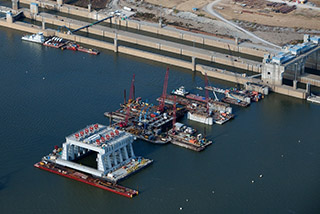Congress is preparing to tackle a new Water Resources Reform and Development Act, in an effort to get the law back on its two-year reauthorization track and improve the WRRDA passed two years ago that mandated major changes in how waterways infrastructure is financed and managed.
WRRDA is one of the most important federal laws affecting the inland navigation industry. The 2014 version, which took nearly seven years to complete, increased the diesel taxes paid by the barge industry that help finance waterways projects. It also changed a cost sharing arrangement on the Olmsted lock and dam project that freed up money in the Inland Waterways Trust Fund for other projects to move forward.
This year's follow-on bill is expected to be far more modest, and could face detours during an election year that will most certainly be charged with partisan politics. Waterways advocates in Washington have toned down their expectations and prepared short lists of priorities as a result.
Lawmakers in the House and Senate are forging ahead. The House Transportation and Infrastructure Committee held a roundtable on Feb. 2 to gather the views of water resources stakeholders and learn of their priorities. The Senate is also planning its version. Congressmen said at the roundtable that they expect the bill would tweak the 2014 law rather than involve a major rewrite.
"We anticipate this bill will be easier to do in the sense that we had a lot of major reforms last time," said Rep. Bill Shuster, R-Pa., chairman of the House committee. He outlined a spring timeframe of producing a bill in his committee, with the hope of passage before Congress recesses this summer for the presidential nominating conventions.
Likely elements of the measure could include changes in a 2014 provision dealing with the Army Corps of Engineers' annual list of projects that meet criteria for possible congressional authorization, a review of efforts to expand alternative funding of projects, and further reducing regulatory burdens and accelerating project reviews done by the Corps.
The American Association of Port Authorities also wants the federal-non-federal cost share for harbor maintenance dredging to be set at 50-50 for depths more than 50 feet, instead of the current 45 feet.
The National Waterways Council Inc., an advocacy group funded by the navigation industry, has four top priorities, according to senior vice president Debra Calhoun.
Among them are changing the major rehabilitation threshold in the Inland Waterways Trust Fund from $20 million to $50 million, opposing additional fees on waterways, such as lockage fees (expected in the president's FY2017 budget that will be released Feb. 9), and opposing lock closures.
WCI says that the 2014 WRRDA required the closure of the Upper Saint Anthony Falls Lock and Dam, shutting the Mississippi River north of Minneapolis to commercial navigation. Such closures, the group says, hinder commercial vessel operators from making point-to point deliveries of cargo on the inland system and penalize businesses located above the closed lock.
Calhoun said WCI realizes the challenges ahead in getting a new WRRDA passed in an election year. "But we've faced stronger opposition before," she said. "We never give up over here."





